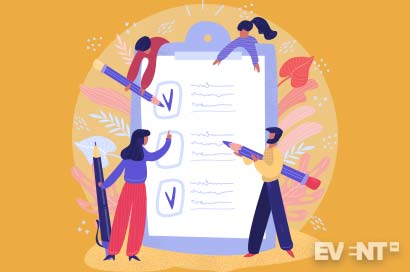Skift Take
54% of event planners cited surveys as a tool they use to gauge attendee satisfaction and overall event success, but how do you know what questions to ask and when?
Achieving a good response rate and obtaining useful survey data is a matter of asking the right questions at the right times.
The first struggle with event survey questions is knowing what to ask to get the most actionable insights. The second is getting attendees to engage with the surveys so you have a good enough response rate to accurately reflect the thoughts and feelings of your audience.
Better survey questions asked with intention will lead to more relevant data that improve the event experience, and timing is crucial. While you can direct people to a survey via email or through your event app, timely onsite prompts via RFID, biometrics and geotagging are becoming popular.
This article explains the 30 best questions to ask in event surveys, and we’ll take you through what each question is for and how and when to ask it for the best results.
Types Of Event Survey Questions
There are generally three different types of event survey questions:
-
QUANTITATIVE
Number driven, NPS-style questions that ask for something quantifiable (i.e. a numerical rating of a product, service or experience) or something that you plan to use to generate useful statistics later.
-
QUALITATIVE
Open-ended questions designed to gain insight into specific experiences and thought processes, which in turn give context to the quantitative data (i.e. “while 35% complained of network issues, but 82% of those respondents were using flip phones”).
-
BINARY
“Yes/No” or checkbox-style questions that are useful for a range of purposes, from collecting quantitative data to handling administrative or logistical requests (i.e. asking for permission to be contacted or ensuring that someone agrees to a privacy policy)
Pre-event
Survey
Questions
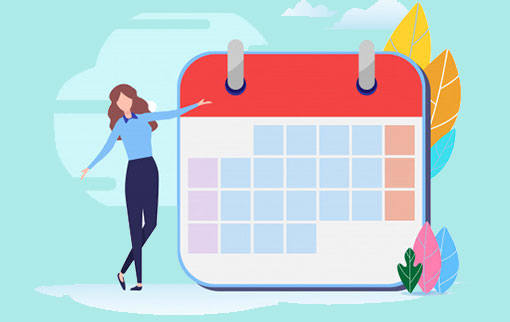
Pre-event surveys help organizers get to know attendees and offer enhanced personalization. Here are some example pre-event survey questions to ask before the event begins.
How did you hear about this event?
Knowing what channels are generating your leads will help you to target your marketing efforts and can allow for greater reach. Not only that, the number of respondents and what marketing they responded to will help you get a heads up on seating numbers, schedules, and Q+A sessions during the event and arranging other events in the future.
- Type: Quantitative Question
- How: Use a single-answer multiple choice question where you offer no more than 5 likely options based on where you’ve advertised (and common-sense things like word-of-mouth).
- When: Non-corporate events that are open to the public or events for which there are multiple marketing funnels at work.
- Where: Likely your registration form, although a post-registration survey could be used if you don’t want to add unnecessary friction to the registration process.
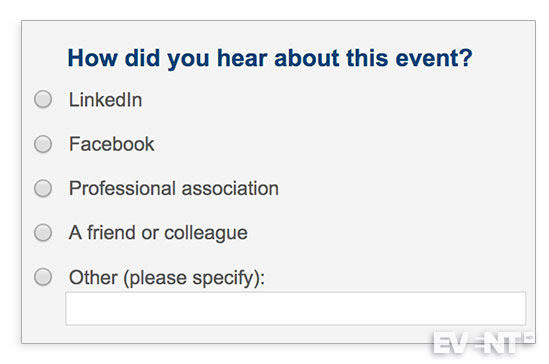
Pro Tip
In addition to paying attention to which channels produce multiple leads, be sure to note which channels are under-performing, and cross reference with your marketing data to determine which channels produce leads that do not turn into customers. If you cannot or do not have marketing automation systems in place to track this information, it is still worth taking note. All of this information will inform future campaigns.
Which speakers are you most excited about?
Speakers are a huge draw to any event. Understanding what level of excitement there is surrounding each of the speakers is extremely useful data to have. It makes a case for sponsorship value, alludes to areas of attendee interest and can help inform the overall event program.
- Type: Quantitative Question
- How: A multiple-choice list of speakers in which respondents can select no more than 30% of the options (e.g. a maximum of 3 speakers out of a list of 10).
- When: Events for which there are multiple speakers, especially if they are from different backgrounds or fields.
- Where: This can be asked almost as soon as the bulk of the speakers have been chosen. Take a poll on social media, or ask during the registration process for early-birds. That said, this information is good to have at all stages leading up to the event, so you could also include it on the post-purchase confirmation page or in a follow-up survey.
Pro Tip
Tweak your itinerary based on the results of this question to allow for the potential of extra seating and photography/videography for your most popular speaker sessions.
Which social media platform do you prefer?
Knowing on which platforms your audience is most likely to engage with your brand will help you direct your resources to the channels with the best returns. It also sets you up to cater the event experience to them on-site and off.
Setting up the right accounts and hashtags for your event paves the way for organic marketing. Attendees posting about what they are learning or how much they enjoy your event act as free advertising for future events.
Creating a brand or event specific hashtag and spreading that on social media or having a competition can really help online engagement.
- Type: Quantitative Question
- How: Format as an optional ‘select all that apply’ multiple-choice style questions.
- When: Almost any corporate or non-corporate event, especially ones aimed at younger attendees such as millennials.
- Where: During the registration process or immediately after on the post-purchase confirmation page.
Pro Tip
Compare the information gained from this question with insights on where attendees actually posted about the event while it was live. These two insights together will inform your marketing in future events.
Have you attended this event before?
Popularity and loyalty speak volumes, and questions like this are key. Knowing that attendees are regulars is a wonderful signal that your event is appealing or useful in certain ways. This question will also help you prove repeat engagement – an important metric for sponsors and shareholders.
- Type: Binary Question
- How: As an optional yes/no multiple-choice style question.
- When: For events that occur monthly, quarterly, or annually. This question applies to corporate and non-corporate events.
- Where: During registration or a post-registration follow-up.
Pro Tip
Consider providing a perk or bonus for repeat attendees. This could be anything from being given priority pricing, additional/exclusive swag, or the ability to weigh in on speakers/workshops/activities, and so on.
Pro Tip
Reward attendees for repeat attendance by helping them through the registration form with autopopulated information. Just remember to ask permission the first time you gather this information and transparently explain what you’ll use it for.
Do you find the location of this event easy to get to?
This is especially useful when you have moved from your usual event space and opted for another. How easy your event is to find and get to will help you figure out if you need to share more detailed directions or possibly plan for dedicated transportation from the airport or major hotels.
- Type: Binary Question
- How: As an optional yes/no multiple-choice style question.
- When: For off-site corporate events or corporate or public events attracting out-of-towners.
- Where: During the booking or post-registration process.
Pro Tip
This question is especially useful for events that are out of town or have moved from a regular location. Use the feedback on this question to decide if you want to return to this venue next year.
Why did you choose to attend this event?
This question should be asked of early-bird registrants (after ticket purchase/RSVP, but prior to the date of the event.) Use this question to help tailor your event experience to confirmed attendees. Based on the responses, tweaks can be made to speaker lineups, swag items, schedule times and more.
- Type: Qualitative Question
- How: Have as an optional short comment question or as a multiple-choice answer.
- When: This question is best suited to large scale events that have a longer lead time between signup and attendance.
- Where: During the post-registration process.
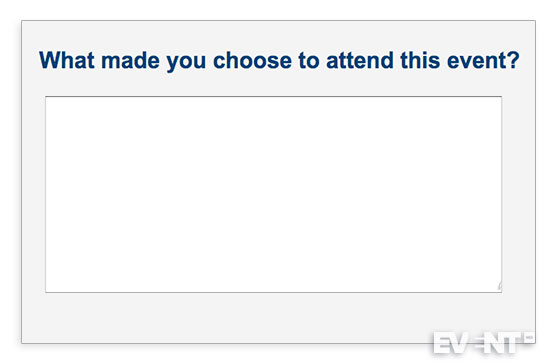
Pro Tip
If using the multiple-choice style format, consider what makes you want to attend an event ie the speakers, the food, the brands, a loved one’s recommendation, the area, and so on. It may be useful to have both styles in place, with the comment box appearing if someone selects ‘other’.
Will you be staying at one of the suggested hotels?
Knowing if attendees plan on staying at the hotel your event is partnered with will help give the event organizers and hotel vendors an idea of the likelihood of filling up the expected block. Like other pre-survey questions, this one also gives insight into areas for potential tweaks for future events, such as the number of hotel rooms needed.
- Type: Binary Question
- How: As a mandatory yes/no choice question. Consider adding a comment box that appears after their selection to let them say ‘why’.
- When: This is best suited for events that are aimed at national or international attendees or if your event is sponsored/partnered with certain local hotels.
- Where: During the booking or post-registration process.
Pro Tip
Pay close attention to the value added for attendees when choosing a hotel to partner with. Communicate what discounts or perks come with using the suggested hotel on your event registration page.
Do you have special needs or accommodations you would like to make us aware of?
It is imperative that we create inclusive spaces for our attendees. Consider accessibility in all areas of event creation. Is there a ramp and elevator on-site? Does the furniture set up allow for ease of maneuverability for attendees using a wheelchair? Is there ample seating for those who have injuries or get tired easily? Having insight into the needs of your registrants can help you support memorable, tailor-made event experiences for them.
- Type: Qualitative Question
- How: As a mandatory yes/no question with multiple-choice options appearing with various needs. Add a comment box to the multiple-choice question for those who select ‘other’.
- When: Corporate or public events.
- Where: During the booking process.
Pro Tip
Interviewing people who have special needs can help you get an idea of what to look out for during planning. Asking this question well in advance will allow you to properly plan for these needs so that they are ready on the day.
Do you have specific dietary restrictions/food allergies we should know about?
Allergies are an all-too-real hindrance for many people. While attendees with food-related allergies usually bring their medicine with them, it is best to bear them in mind when serving food at an event.
With the variety of dietary restrictions people have today, options are no longer optional. If food is part of your program, you have to respect the restrictions and dietary choices of your participants or they will not have a good experience.
- Type: Qualitative Question
- How: As a mandatory multiple-choice answer with each allergen as an answer. Consider adding an open comment box and requesting attendees make you aware of any severe or life-threatening allergies.
- When: During corporate or public events where food is being served to attendees.
- Where: During the registration process.
Pro Tip
Asking this question in advance can help you plan how many alternative meals will be needed during the event. Consider allowing registrants to help create the menu via polling options. Show them menus with allergen information both in advance and during the event.
Was there any event information that was difficult for you to find/understand?
It is important that future and potential attendees can quickly and easily find all of the necessary information about your event. Figuring out where people get confused in the event registration process is imperative for improving your engagement rate going forward.
- Type: Qualitative Question
- How: As an optional yes/no multiple choice question. If the attendee selects ‘yes’, have a comment box appear so that they can let you know what needs improving.
- When: Public or corporate events, especially new or first-time ones.
- Where: At the end of the booking or post-registration process.
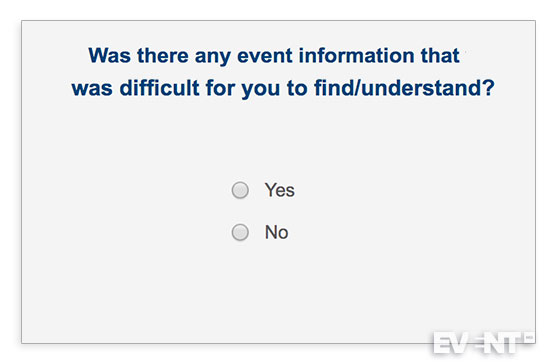
Pro Tip
This question is especially important to ask of people who chose not to opt into your event. Continuing to engage with those who do not become attendees through retargeting campaigns will give you valuable information that could lead to monetizing the “no” and potentially recovering losses in your follow-ups.
What’s your favorite ice cream flavor?
Consider asking a fun, random question of your attendees. It acts as an ice breaker and a “get to know you” question. This is especially useful if you intend to have this feature on attendee profiles for the event as a conversation-starter during networking events.
- Type: Qualitative Question
- How: This question works as an optional multiple-choice answer with various flavors listed or an open short-answer question.
- When: Corporate or public events, especially events that are more casual or networking-oriented.
- Where: During the post-registration process.
Pro Tip
Use the results of this question to come up with a unique ice breaker at your event for attendees, or display the results at the event; one way to display this would be on attendee profiles, for example.
Mid Event Survey Questions

Surveys during the event provide ongoing qualitative and quantitative data on the attendee experience. They allow you to take advantage of moments when the things you’re asking about are fresh in the attendees’ minds, and can provide insights that let you know if you have to pivot or modify your strategy on a dime.
How would you rate the venue?
A first impression of the venue is a great metric to have, especially because post-event survey questions about the overall event can be tainted if attendees have a negative experience during the event. Having both a first and last impression will give event organizers a better holistic view of attendee satisfaction.
- Type: Quantitative Question
- How: As an optional scale of 1-5 that indicates what 1 and 5 stand for (e.g. ‘greatly dissatisfied’ and ‘greatly satisfied,’ respectively) with a ‘why’ comment box.
- When: Corporate or public events, especially if your usual location has changed.
- Where: Send this question within your event app as soon as attendees arrive and check-in.
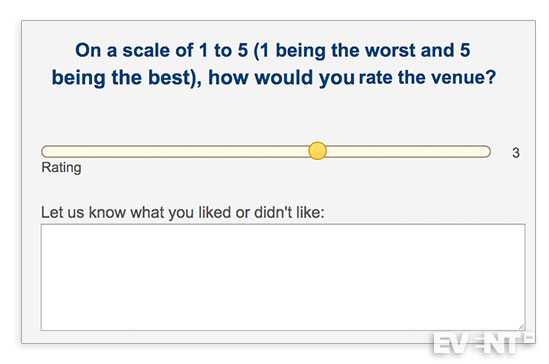
Pro Tip
If your survey platform allows for it, dynamically produce additional questions for ratings under 3 (or whatever the halfway point on your scale is) to home in on the problem with the venue. This could prompt them to similarly rate aspects like location, WiFi, infrastructure, aesthetics, etc. There’s no use finding out people didn’t like it if you don’t know what they didn’t like about it.
Are you satisfied with check-in?
Check-in can often be a hassle and is one of the first opportunities event organizers have to make an impression on attendees. Be sure to inquire about the check-in process, either as part of the process itself or as an immediate follow-up.
- Type: Binary Question
- How: A mandatory yes/no question with a ‘why’ comment box.
- When: At check-in or immediately after at corporate or public events.
- Where: Send this question within your event app as soon as attendees arrive and check-in.
Pro Tip
Follow this question up with an open-ended one that leaves room for suggestions of improvement. Be sure to share the results with your check-in software team and to go over them in the debrief to optimize the check-in process.
Pro Tip
If your event app allows for it, have the alert include the question and options itself, so that attendees can just close the alert by answering the question. If you’re not going to follow up with a qualitative question and you’re not concerned about tracking who responded, you can also provide a feedback stand on the way out of the check-in area. These are little stands or tables with buttons that correspond to a rating; these often take the form of a smiley face and frowny face, or numbers from 1 to 5.
Are you comfortable?
There are many ways to ascertain the answer to this question depending on the situation, and you should pay attention to your attendees’ body language and general attitudes throughout the event. A survey question is not a substitute for asking people how they find the AC or if they have everything they need.
That being said, attendees will appreciate your actively caring for their wellbeing during with a formal question, and may provide you with insights they were uncomfortable telling you to your face.
- Type: Qualitative
- How: As an optional yes/no question with a comment box appearing afterward.
- When: Any type of event, especially those that run for hours at a time or involve a lot of walking or standing.
- Where: Can be sent via prompts in the event app or in post-session and end-of-day surveys.
Pro Tip
Consider combining responses to this question with data from RFID or biometric technology to make necessary adjustments to things like traffic flow and temperature.
How would you rate that speaker/workshop/activity?
This question can explain which speakers should be brought back next year and which should be replaced. It also gives insight into the sessions and topics available at the event attendees are most interested in.
- Type: Quantitative Question
- How: As a set of mandatory questions with each activity or speaker as their own question and a rating scale underneath.
- When: At the end of each activity or session at any event with a series of activities.
- Where: Prompts on the event app are a great way to catch people right after speaker sessions or workshops as people will likely want to check their phones between sessions. This works especially well if your event app is native and can send push notifications on each person’s device. That said, you can also prompt people during the session itself with QR codes that link to the survey on display at exits or within the presentation itself.
Pro Tip
Consider putting together a survey analytics dashboard to monitor results in real-time. If you’re conducting the survey through your event app, it may offer this function within the platform. Alternatively, this can be done using automation platforms or categorizing certain answers together. Engagement and satisfaction can be measured and monitored with keyword specific content streams. (You could set filters for “weak coffee,” “long line” and “great workshop” for example).
Which was your favorite breakout session/speaker/presentation/menu item?
Events are an excellent time to showcase any new talent within the industry. From the catering to the speakers to the products, having a concentrated number of influential people in the business to witness the launch of a new product brings a level of exclusivity and excitement to an event.
- Type: Qualitative Question
- How: As an optional multiple-choice question. Consider adding a ‘why’ comment box if selected.
- When: Corporate or public events in which you’re trying something new.
- Where: Directly after the activity in which attendees are exposed to the new thing they’re ranking.
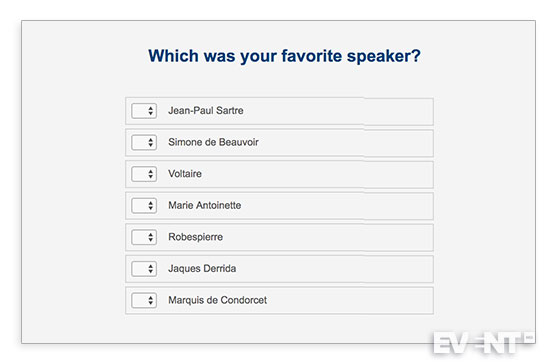
Pro Tip
Frame these types of questions as ongoing polls/contests and announce crowd favorites throughout the event to boost engagement. These polls can easily be done with a #WhichIsBetter hashtag on the appropriate social media channel.
What are your thoughts on the event thus far?
Have volunteers or staff members that float through the event and engage with attendees and vendors during the event. These “floaters” can ask specific questions, or they can interact as attendees themselves to provide authentic feedback on the “feel” of an event from the attendee perspective.
- Type: Qualitative Question
- How: As an optional open text box.
- When: At regular intervals during longer 3+ day-long events (i.e. at the end of the first day, second day, and third day) or once a major event component has been delivered..
- Where: As with most mid-event questions, the event app is a great vehicle for timely responses, though you should be engaging people in person as well.
Pro Tip
Ask during breakout sessions or break times to give people a chance to reflect on the event thus far. Asking them right after a specific session or activity will charge their response with their impression of that specific event.
Are you interested in this session/product/workshop etc?
Event apps allow for targeted insights on attendee engagement during an event. It is a great idea to leverage this information to create suggestions and to inform your content curation process both for this and future events.
- Type: Binary Question
- How: As an optional yes/no question asked an hour before the activity in question. You may also use RFID technology to prompt people with the question when they’re near a session they might be interested in, thereby also letting them know about something cool they might otherwise have missed.
- When: Public or corporate events with several breakouts or content verticals, or any event in which you’re experimenting with content.
- Where: Via the event app or in the mid-conference survey.
Pro Tip
Keep track of what attendees suggest or take up. Sponsors love knowing how many people interacted with which session, which exhibitors were worth the money, and which products and services were attractive to attendees.
How would you rate the audio?
Asking about audio during an event, rather than after, gives event organizers more data. Is there a particular breakout or lecture room that gave more audio trouble than others? Do certain speakers require special accommodations in order to be heard or understood? Are attendees able to be heard during Q+A sessions?
- Type: Quantitative Question
- How: As an optional ‘1-5’ or ‘greatly satisfied-greatly dissatisfied’ question accompanied by an open text box for more information or suggested improvements.
- When: Any conferences that use speakers or headphones.
- Where: Via the app or email.
Pro Tip
It’s also a good idea to survey the speakers themselves to ask how audio and other technology supported their speeches and presentations.
Is the conference layout easy for you to navigate?
This question, when left open-ended, can provide important details regarding accessibility and flow at the event venue. Knowing what was difficult to navigate and where can help you control routes and traffic during your event, and let you know if you need to erect some maps on onsite signage or promote the event app for navigation.
- Type: Qualitative Question
- How: As an optional open text box for long-form answers.
- When: During or towards the end of any events that are spread across a wide area, multiple buildings, or any with a large trade show component.
- Where: Via the app or by email.
Pro Tip
If you’re tracking footfall using an event app, RFID, or some other technology, that should give you an indication of problematic areas. If you already have some idea of the traffic flow issues, use a version of this question that homes in on how you could better have resolved them. Were the maps hard to access? Was the layout counterintuitive? Pairing this with pointed yes/no binary questions or 1-5 rating questions can help you define the problem.
Post Event Survey Questions
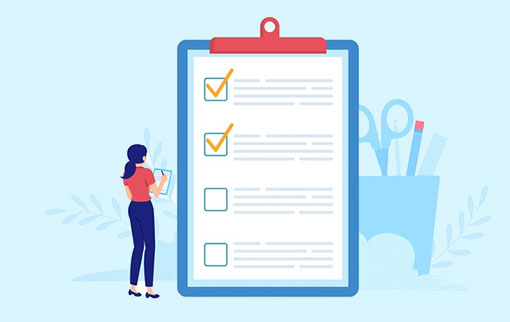
Post-event surveys help to extend the engagement with attendees, gather feedback, and reinforce calls-to-action. Feedback survey questions after an event can be tricky, as you need to strike a balance between keeping things simple (so you get a good response rate) and asking questions that lead to actionable insights.
How likely are you to recommend this event to a friend or colleague?
One of the most common post event survey questions, the results are commonly referred to as your ‘NPS,’ or ‘net promoter score’. Your NPS is the ultimate satisfaction indicator because it forces the respondent to assess the value of your event but asks in a way that is simple and nuanced at the same time. Someone who answers with a 8-10 rating can be considered a promoter who is likely to speak well of your event. Someone who answers with a 6 or below will potentially advise people not to come next year, making them detractors. Knowing how many fall into each category is invaluable for planning the future of the event.
- Type: Quantitative Question
- How: As a ‘1-10’ scale rating.
- When: After any event that people get to opt into.
- Where: On the app or post-event survey.
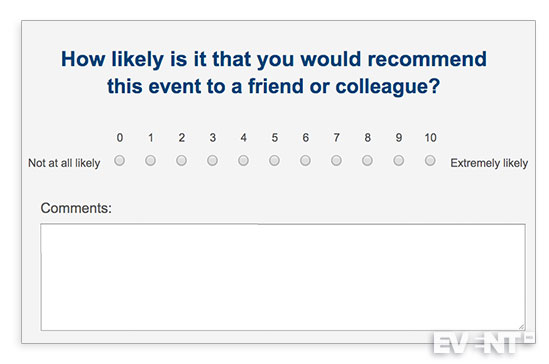
Pro Tip
Pose this question to speakers and vendors as well as attendees to boost your speaker and vendor network for future events.
Pro Tip
Remember to follow up with a qualitative question. Ask not only what the detractors didn’t like, but what the promoters did like. Use that information to double-down on things that were well received and modify things that weren’t.
Will we see you next year?
Similarly, this blatant and direct question is a great indicator of overall attendee satisfaction. It can be sent out during the feedback survey questions after the event.
- Type: Binary Question
- How: As a yes/no questions with a pop up ‘why’ comment box.
- When: After any recurring event.
- Where: Via email, in a targeted event specific group (on Facebook or LinkedIn) or within the event app itself.
Pro Tip
A fun way to ask this question is with signage at the exits of the event. Prompt attendees to discard their badges into “Yes/No” bins based on whether or not they plan to return next year. This gives you valuable data and also reduces the amount of errant badge waste that will be littered across the venue grounds.
What did you like most about the event?
This open-ended question will give you great insight into what specifically attendees liked about your event, giving attendees the freedom to speak more to their overall event goals and how the event satisfied them. While you may find insights about event particulars – your marketing campaign, the networking opportunities, or a particular swag or menu item – you will also gain more holistic insights into your attendees’ success at the event.
- Type: Qualitative Question
- How: As a mandatory comment box that allows for longer answers.
- When: After any event with multiple activities or verticals.
- Where: Via the app, email, or social media.
Pro Tip
If your event activities are really varied, rephrase the question to ask respondents their favorite thing in each category. “What was your favorite session?” “What was your favorite workshop?”
What did you dislike about the event?
Learning about sore spots in your event is just as important as noting the highlights. Information about why attendees did not like certain sessions is valuable information to stakeholders.
- Type: Qualitative Question
- How: As a mandatory open-ended comment box style question.
- When: After any public or corporate event.
- Where: Via the app, email, or social media.
Pro Tip
Be as invested in these answers as you are in all the rest. Data suggests that negative interactions linger longer than positive ones. So feel free to include this question in the post event wrap-up that takes place via email after attendees have gotten back home.
How friendly/knowledgeable did you find the staff?
Event staff and volunteers are a crucial element to a successful event. Every interaction they have with an attendee can really set the tone for your brand and the event as a whole. While you can include it in the mid-event survey questions, putting this question in the post event survey will work as well.
- Type: Quantitative Question
- How: A ‘1-5’ scale rating with an optional comment box.
- When: Public or corporate events.
- Where: Via the app, email, or social media
Pro Tip
Use dynamic form logic to ask those who had a negative experience for their email contact and permission to reach out to them. Hopefully, those who were displeased with the event staff are few and far between, so reaching out to them to find out more information and offer a personal apology will go a long way in salvaging their event experience and proofing future events against similar issues.
Did this event meet your expectations? Did you accomplish what you set out to do?
This question asks attendees to remember why they came in the first place and decide whether the event delivered. Was the purpose educational? Was it meant to facilitate lucrative connections? Attendees at the same event might have different goals, so leaving the question a little vague and adding a comment box keeps it applicable to everyone.
- Type: Binary Question
- How: As a yes/no answer with an optional ‘why’ or ‘why not’ open text box following the respondent’s selection.
- When: Any event with a business case for attendees.
- Where: Via the app or in an email survey.
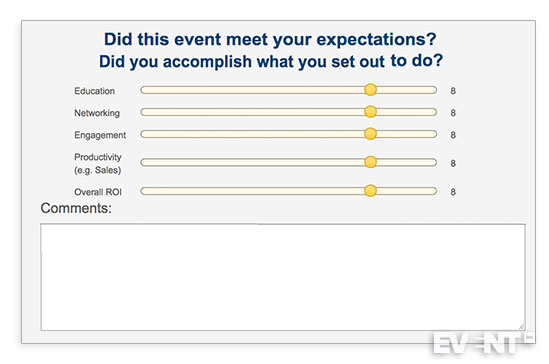
Pro Tip
An alternative (or complimentary) question you could ask is whether there is anything your attendees would like to have seen or done that could have improved the experience. At the end of the day, it’s good to know that you delivered on your promises, but sometimes you want to explicitly ask for constructive feedback – especially if your survey is not 100% anonymous.
How would you rate the quality of networking opportunities at this event?
One of the main reasons people attend live events is for the potential to meet new and useful people within the industry. It is really important to have a gauge of how your attendees felt about the networking opportunities at your event, as positive feedback can be enticing for future installments.
- Type: Quantitative Question
- How: As a mandatory scale of ‘1-5’ with a pop-up comment box.
- When: Corporate events, especially ones that focus on networking.
- Where: Via the app, email, or social media
Pro Tip
Consider facilitating networking opportunities at your event by assigning attendees to a buddy or a group based on simile needs. Connect registrants before the event begins and share contact info in your event group and event app.
Did you learn anything new or valuable at this event?
It is very important as an event organizer to have a grasp on what the actual event takeaways were so you can learn about any potentially problematic discrepancies. Organizers can have ideas going in about what messages they intend to share, and it is important to know if those messages were successfully communicated.
- Type: Qualitative Question
- How: As a yes/no answer with a ‘why’ open text box.
- When: Corporate or industry events where education and information are the focus.
- Where: Via the app or post-event email survey.
Pro Tip
Use dynamic form logic to present people who respond ‘yes’ with a request for permission to use their response as a testimonial for future events. Alternatively, if this is your intention, be sure to note this at the beginning of the survey.
Did you find the event technology helpful and easy to use?
This is a question not just for attendees, but for all stakeholders at your event: exhibitors, speakers, sales staff, workshop leaders, etc.
New technology is penetrating every strata of the events industry, and it can be a lot to keep up with. If you’re providing lead capture apps to exhibitors or dynamic polls and collaborative presentation slides to your speakers, you want to ensure that they were worth the investment and that the people they were intended to help made the most of them.
- Type: Qualitative Question
- How: As a yes/no binary question with an open-text box.
- When: Any event in which a new technology has been introduced.
- Where: Via the app or email post-event follow-up.
Pro Tip
Pay attention to your respondents’ sentiment. Did they find the technology onerous or were they excited about it, but just uncomfortable using it? Could they see the value? Issues with event technology adoption can stem from a lot of places, and this question can help you determine if you need to better explain the value of the tech or deliver better training/onboarding.
Do you have any feedback or suggestions to share?
This is often the last question in a post-event survey. It is an open-ended question that allows attendees to say anything on their minds that they may not have had the time or opportunity to mention before. This question also helps attendees to feel valued and as if they have a voice.
- Type: Qualitative Question
- How: As an optional long-form comment box.
- When: At the end of any event.
- Where: Via the app or post event email survey.
Pro Tip
Don’t put a character limit on this question. Give attendees free reign to tell you however much they need to. All of their feedback is valuable, and that should be reflected in the post event survey.
Best Practices For Any Survey
While the questions we covered were typically best asked in a particular way and at a particular time, there are good things to keep in mind whenever you’re soliciting your attendees for feedback. Here are a few of them:
In general, it is a good idea to keep surveys as short as possible. Don’t attempt to fit every question into one long survey, as it may discourage attendees from participating.
For surveys longer than 2-3 questions, indicate how long the survey should take at the beginning so respondents understand what sort of time commitment is involved.
For open-ended questions, especially those with a fixed word limit, indicate the word or character limit and how many are remaining when possible.
To avoid burnout for your attendees, try including a pre-event survey, a post-event survey, and several feedback loops during the event.
Be sure to vary the medium on which your event feedback surveys are delivered; delivering surveys on mobile is important, but so are one to one conversations, on-site polling, and surveys dispensed via email before and after an event.
CONCLUSION
Event survey data is the key to optimizing and improving the experience of your attendees. Understanding what questions to ask and when allow event organizers to maximize response rates and gather actionable information. Both quantitative and qualitative data can be used to validate their choices to sponsors and stakeholders, prove event ROI and engagement, and tweak future events and marketing campaigns to ensure attendee satisfaction.
